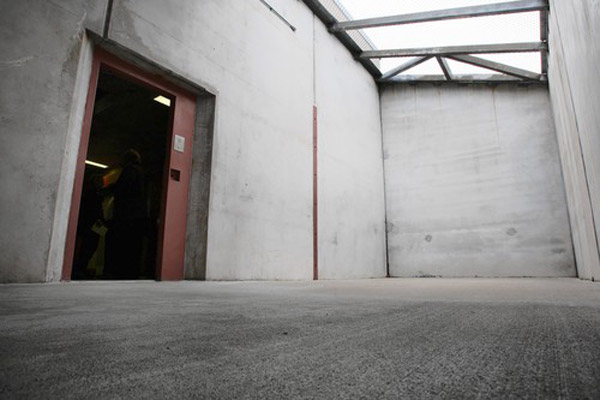
Yesterday it was Medicaid; today, the Trib reports that one of Pat Quinn's ideas for cutting the state budget is to shut down Tamms Correctional Center, among many social-services and law-enforcement cuts. Tamms is very, very expensive; as Gary Marx reported in 2009, the cost for housing inmates there is $27 million a year to house 245 inmates, because per-inmate costs are triple the state average. Marx was one of the first reporters inside Tamms's walls in years, and he filed a compelling report on the state supermax.
Conditions are harsh—and meant to be. For at least 23 hours a day, prisoners sit in solitary confinement in 7-by-12-foot cells. There is no mess hall—meals are shoved through a chuckhole in cell doors. Contact with the outside world is sharply restricted. For a rare visit from relatives or friends, inmates are strip-searched, chained to a concrete stool and separated from visitors by a thick glass wall. There are no jobs and limited educational opportunities.
The extreme control Tamms exercises over its inmates comes at a substantial cost; in contrast to so much of Illinois's prison system, Tamms is usually only about half full. But narrowly speaking, it works, as Scott Turow found in his investigation the death penalty for the New Yorker, "To Kill Or Not to Kill":
Generally speaking, Tamms inmates are either gang leaders or men with intractable discipline problems. I wanted to visit Tamms, hoping that it would tell me whether it is possible to incapacitate people like Brisbon, who are clearly prone to murder again if given the opportunity.
[snip]
In part because the facility is not full, incarceration in Tamms costs about two and a half times as much as the approximately twenty thousand dollars a year that is ordinarily spent on an inmate in Illinois, but the facility has a remarkable record of success in reducing disciplinary infractions and assaults.
Turow was there to visit the I-57 Killer, Henry Brisbon, who had, prior to Turow's visit: murdered two people, and allegedly a third; gone to prison for rape and armed robbery; played a role in the 1979 Stateville takeover, a watershed moment in American incarceration; killed a prisoner; stabbed fellow inmate John Wayne Gacy; been accused of seriously assaulting another inmate; and been accused of stabbing a guard. Turow chose Brisbon because he's historically been an example of the worst of the worst. Later, Turow told BusinessWeek:
It's disquieting. You look at him and he's a pretty ordinary-looking, normal human being. He's not very big. But I know that the prisoners who have lived with him are really scared of him. One of the more interesting things I've [discovered] is that there are prisoners who actually really scare other prisoners. Even killers recognize that some people are sort of programmed to do mayhem.
But Tamms wasn't designed to house inmates for very long, as Jeffery Felshman reported for the Reader:
Tamms was supposed to serve as a sort of shock treatment for inmates with severe behavior problems. The 1993 Illinois Task Force Report on Crime and Corrections specified that "the fundamental principle underlying the Super-max institution is that it is a management tool for addressing specific security problems that hinder delivery of essential services and anti-recidivism activities to the general population—it is not simply a place to put 500 inmates in an otherwise overcrowded system. To serve its purpose, inmates must move in and out, based on some objective classification and standards."
As Tamms Year Ten and other human rights organizations stepped forward to speak for Robert Foor, a 33-year-old who died in June after nearly 11 years in isolation at the Tamms Closed Maximum Security Unit, the Illinois Department of Corrections announced its plans to reform the southern Illinois “supermax” prison.
[snip]
Foor had been in Tamms since July 1998 when he was found unresponsive in his cell on June 23. According to a recently-released autopsy report, he died due to hyponatremia, a condition in which there is not enough sodium in the blood (commonly referred to as water intoxication).
Two weeks earlier, Foor had filed a grievance with IDOC, alleging that Tamms had withheld his medication — he had taken 17 different types while incarcerated, he stated — and therapy as a form of punishment [see “Private hell, July 1]. In the grievance, he also affirmed that he had been diagnosed with personality disorder with antisocial, borderline and paranoid features, among other conditions.
Foor originally went to prison for burglary; in-prison assaults sent him to Tamms. In 2010, a federal judge declared the conditions at Tamms unconstitutional, in part because inmates were held for so long in solitary confinement.
According to the Sun-Times, Tamms's maximum-security inmates would be sent to Pontiac's maxiumum-security wing under Quinn's proposal—which itself was on the chopping block until Quinn saved it in 2009.
Photograph: Chicago Tribune


